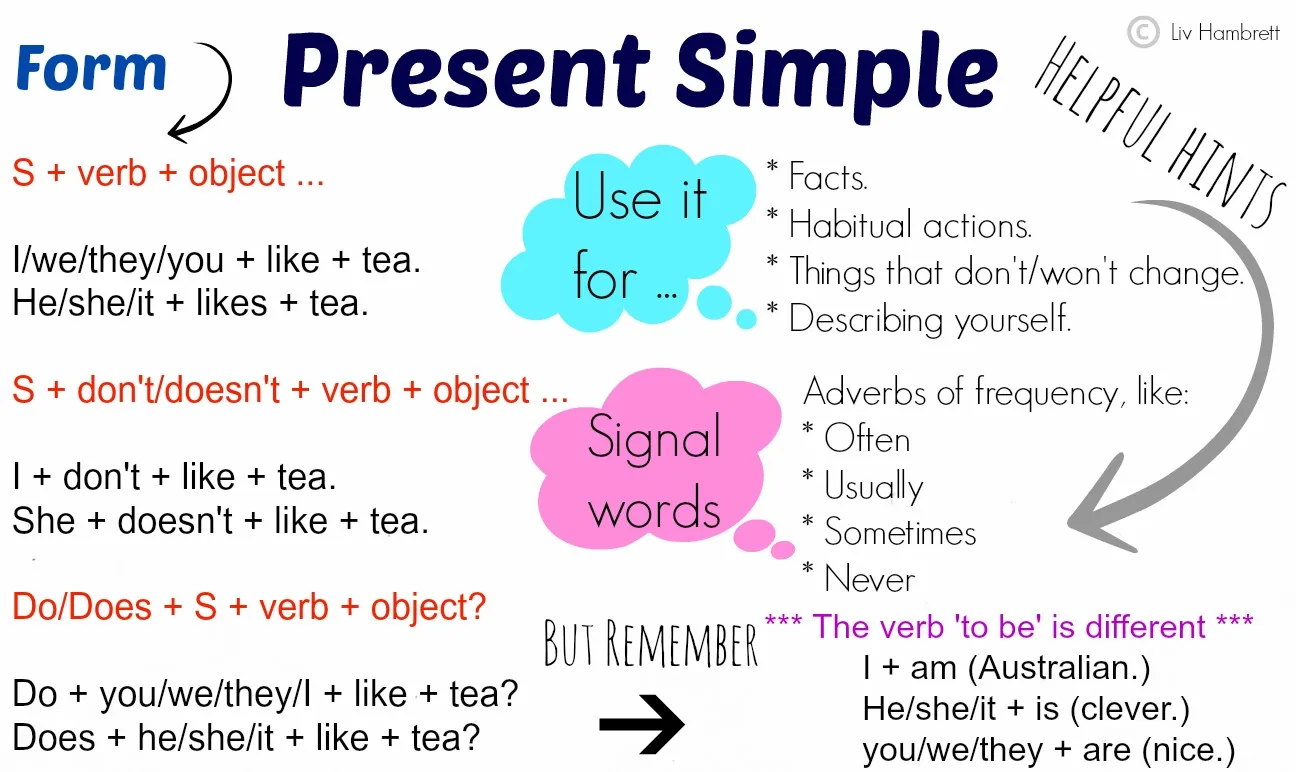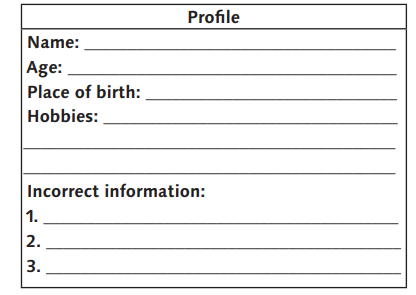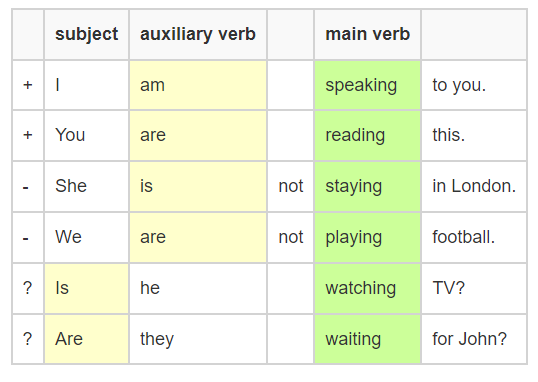Module 1
Starting out!
GRAMMAR
*First of all we have to explain the difference between the simple present tense and the present continuous.
1.The Present Simple (affirmative , negative, and question)
Simple Present Uses
1: We use the present simple when something is generally or always true.
People need food.
It snows in winter here.
Two and two make four.
2: Similarly, we need to use this tense for a situation that we think is more or less permanent. (See the present continuous for temporary situations.)
Where do you live?
She works in a bank.
I don't like mushrooms.
3: The next use is for habits or things that we do regularly. We often use adverbs of frequency (such as 'often', 'always' and 'sometimes') in this case, as well as expressions like 'every Sunday' or 'twice a month'. (See the present continuous for new, temporary or annoying habits).
Do you smoke?
I play tennis every Tuesday.
I don't travel very often.
4: We can also use the present simple for short actions that are happening now. The actions are so short that they are finished almost as soon as you've said the sentence. This is often used with sports commentary.
He takes the ball, he runs down the wing, and he scores!
*Form:
Sub + v(base) + C. (For plural subject) they / you / we / I
They play out.
Sub + v(s/es) +C. (For singular subject) she / he / it
Salma goes to the school everyday.
**************************************************
The Present Simple (negative)
Form : Sub + don't/ doesnt + v (base)
Remmember: don't : for plural
doesn't : for singular
1.She does'nt eat fish.
*************************************
The Present Simple (interrogative)
*Form : Do / Does +sub + v(base) +C.
1.Do you like eating out?
2. Does Sam go watch horror movies?
2. We don't wear watches
********************************

Remember: 'be' is different from the other verbs in this tense. Let's look at 'be' first:
| Positive | Positive Short Form |
| I am | I'm |
| you are | you're |
| he is | he's |
| she is | she's |
| it is | it's |
| we are | we're |
| they are | they're |
Next, here's the negative. It's very easy. You only add 'not'.
| Negative | Negative short form |
| I am not | I'm not |
| you are not | you aren't |
| he is not | he isn't |
| she is not | she isn't |
| it is not | it isn't |
| we are not | we aren't |
| they are not | they aren't |
| Yes / No Questions |
| am I ? |
| are you ? |
| is he ? |
| is she ? |
| is it ? |
| are we ? |
| are they ? |
*********************************************************************
2. Presint continuous:
also called Present Progressive)
We often use the Present Continuous tense in English. It is very different from the Present Simple tense, both in structure and in use.
We use the Present Continuous to talk about:
- action happening now
- action in the future
- ********************************************
- The main verb is invariable in present participle form: -ing
-
For negative sentences we insert not between the auxiliary verb and the main verb.
For question sentences, we exchange the subject and the auxiliary verb.
Look at these example sentences with the Present Continuous tense:
-
The structure of the Present Continuous tense is:
subject + auxiliary be + main verb conjugated in Present Simple am, are, is present participle (-ing) - *********************************************************
-
The auxiliary verb (be) is conjugated in the Present Simple: am, are, is
-
-
*More examples:
- We're eating at Joe's Cafe tonight. We've already booked the table..
- They can play tennis with you tomorrow. They're not working.
- When are you starting your new job?
- ****************************************************
| Basic rule: |
Just add -ing to the base verb: go : going walk: walking be: being |
||
|---|---|---|---|
vowels = a, e, i, o, u
| stop | → | stopping |
| run | → | running |
| begin | → | beginning |
| Exception | If the base verb ends in ie, change the ie to y: | ||
|---|---|---|---|
| lie | → | lying | |
| die | → | dying | |
| Exception | If the base verb ends in vowel + consonant + e, omit the e: | ||
| come | → | coming | |
| mistake | → | mistaking | |
***************************************************
GRAMMAR
SB page 7 / exercise 1:
Circle the correct form of the verbs.
1. Amal drives/is driving her children to school every day.
2. I’m sorry I can’t go shopping with you. I go/am going to the theatre with my parents.
3. James is reading/reads a book about Jordan’s historical places at the moment.
4. He usually is wearing/wears a uniform to school, but today he is wearing/ wears a thobe
The answer: 1. drives; 2. am going; 3. is reading; 4. wears, is wearing
**************************************************
SB page 7 / exercise 2:
Make questions using the tables below. Then, answer them in pairs.

The answer: Are they playing video games? Do you watch car racing with your dad?
Do you watch TV on school days? Do you visit the museum?
Are they learning how to swim?
Do you visit your grandparents on Fridays?
Are they playing with their friends?
Are they learning Spanish at school?
**********************************************************************
SB page 7/ exercise 3:
4 Follow the Listening Strategies. Then, take notes as you listen to Hamidah’s profi e.
| Hamidah is 15 and she has three sisters, Manal, Nawal and Salma, and one brother, Jamal. Her father’s a dentist and her mother’s a nurse. She lives with her family in Amman, Jordan. They live in a big flat. Hamidah shares her bedroom with her sister Salma. Her best friend is Noura who is 14 years old. Hamidah and Noura go to the same school in Amman. They love English and they are members of the Debating Club. Hamidah has got two aunts and three uncles. |
******************************************************************************
SB page 7/ exercise 6:
6 Listen again to Hamidah’s profile and check your answer.
The answer:
1. Hamidah has three sisters.
2. Her father’s a dentist.
3. They live in a big flat.
4. Hamidah and her friend Noura go to the same school in Amman.
5. Hamidah and her friend Noura love English.
***************************************************************************************
SB page 7 / exercise 7:
▼ Over to you . . .
7 Now, write a similar profi le for one of your friends. Write three incorrect details about your friend. Read your profile. The others have to guess the incorrect information.

The answer: Student's own answer.
